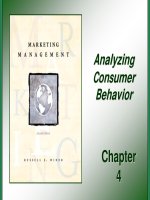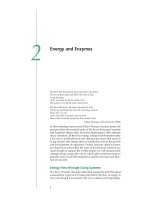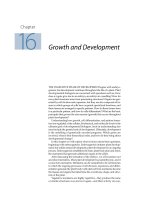OB11 chapter 04 personality and emotions
Bạn đang xem bản rút gọn của tài liệu. Xem và tải ngay bản đầy đủ của tài liệu tại đây (484.38 KB, 31 trang )
eleventh edition
organizational
behavior
stephen p. robbins
Chapter 4
Personality and
Emotions
ORGANIZATIONAL BEHAVIOR
S T E P H E N P. R O B B I N S
E L E V E N T H
© 2005 Prentice Hall Inc.
All rights reserved.
E D I T I O N
WWW.PRENHALL.COM/ROBBINS
PowerPoint Presentation
by Charlie Cook
OBJECTIVES
LEARNING
After studying this chapter,
you should be able to:
1. Explain the factors that determine an
individual’s personality.
2. Describe the MBTI personality framework.
3. Identify the key traits in the Big Five
personality model.
4. Explain the impact of job typology on the
personality/job performance relationship.
5. Differentiate emotions from moods.
6. Contrast felt versus displayed emotions.
© 2005 Prentice Hall Inc.
All rights reserved.
4–3
7. Explain gender-differences in emotions.
8. Describe external constraints on emotions.
9. Apply concepts on emotions to OB issues.
LEARNING
O B J E C T I V E S (cont’d)
After studying this chapter,
you should be able to:
© 2005 Prentice Hall Inc.
All rights reserved.
4–4
What
What is
is Personality?
Personality?
Personality
The sum total of ways in which an individual reacts
and interacts with others.
Personality Traits
Enduring characteristics
that describe an
individual’s behavior.
Personality
Personality
Determinants
Determinants
• •Heredity
Heredity
• •Environment
Environment
• •Situation
Situation
© 2005 Prentice Hall Inc.
All rights reserved.
4–5
The
The Myers-Briggs
Myers-Briggs Type
Type Indicator
Indicator
Myers-Briggs Type Indicator (MBTI)
A personality test that taps four characteristics and
classifies people into 1 of 16 personality types.
Personality
PersonalityTypes
Types
• •Extroverted
Extrovertedvs.
vs.Introverted
Introverted(E
(Eor
orI)I)
• •Sensing
Sensingvs.
vs.Intuitive
Intuitive(S
(Sor
orN)
N)
• •Thinking
Thinkingvs.
vs.Feeling
Feeling(T
(Tor
orF)
F)
• •Judging
Judgingvs.
vs.Perceiving
Perceiving(P
(Por
orJ)J)
© 2005 Prentice Hall Inc.
All rights reserved.
4–6
MyersMyersBriggs
Briggs
Sixteen
Sixteen
Primary
Primary
Traits
Traits
© 2005 Prentice Hall Inc.
All rights reserved.
4–7
The
The Big
Big Five
Five Model
Model of
of Personality
Personality Dimensions
Dimensions
Extroversion
Sociable, gregarious, and assertive
Agreeableness
Good-natured, cooperative, and trusting.
Conscientiousness
Responsible, dependable, persistent, and organized.
Emotional Stability
Calm, self-confident, secure (positive) versus nervous, depressed,
and insecure (negative).
Openness to Experience
Imaginativeness, artistic, sensitivity, and intellectualism.
© 2005 Prentice Hall Inc.
All rights reserved.
4–8
Major
Major Personality
Personality Attributes
Attributes Influencing
Influencing OB
OB
Locus of control
Machiavellianism
Self-esteem
Self-monitoring
Risk taking
Type A personality
© 2005 Prentice Hall Inc.
All rights reserved.
4–9
Locus
Locus of
of Control
Control
Locus of Control
The degree to which people believe they
are masters of their own fate.
Internals
Individuals who believe that they
control what happens to them.
Externals
Individuals who believe that
what happens to them is
controlled by outside forces
such as luck or chance.
© 2005 Prentice Hall Inc.
All rights reserved.
4–10
Machiavellianism
Machiavellianism
Machiavellianism (Mach)
Degree to which an individual is pragmatic,
maintains emotional distance, and believes
that ends can justify means.
Conditions
ConditionsFavoring
FavoringHigh
HighMachs
Machs
••Direct
Directinteraction
interaction
••Minimal
Minimalrules
rulesand
andregulations
regulations
••Emotions
Emotionsdistract
distractfor
forothers
others
© 2005 Prentice Hall Inc.
All rights reserved.
4–11
Self-Esteem
Self-Esteem and
and Self-Monitoring
Self-Monitoring
Self-Esteem (SE)
Individuals’ degree of liking
or disliking themselves.
Self-Monitoring
A personality trait that measures
an individuals ability to adjust
his or her behavior to external,
situational factors.
© 2005 Prentice Hall Inc.
All rights reserved.
4–12
Risk-Taking
Risk-Taking
High Risk-taking Managers
– Make quicker decisions
– Use less information to make decisions
– Operate in smaller and more entrepreneurial
organizations
Low Risk-taking Managers
– Are slower to make decisions
– Require more information before making decisions
– Exist in larger organizations with stable environments
Risk Propensity
– Aligning managers’ risk-taking propensity to job
requirements should be beneficial to organizations.
© 2005 Prentice Hall Inc.
All rights reserved.
4–13
Personality
Personality Types
Types
Type A’s
1. are always moving, walking, and eating rapidly;
2. feel impatient with the rate at which most events take place;
3. strive to think or do two or more things at once;
4. cannot cope with leisure time;
5. are obsessed with numbers, measuring their success in
terms of how many or how much of everything they acquire.
Type B’s
1. never suffer from a sense of time urgency with its
accompanying impatience;
2. feel no need to display or discuss either their achievements
or accomplishments;
3. play for fun and relaxation, rather than to exhibit their
superiority at any cost;
can relax
without
©4.2005
Prentice
Hallguilt.
Inc.
All rights reserved.
4–14
Personality
Personality Types
Types
Proactive Personality
Identifies opportunities,
shows initiative, takes
action, and perseveres
until meaningful change
occurs.
Creates positive change
in the environment,
regardless or even in
spite of constraints or
obstacles.
© 2005 Prentice Hall Inc.
All rights reserved.
4–15
Achieving
Achieving Person-Job
Person-Job Fit
Fit
Personality-Job Fit
Theory (Holland)
Identifies six personality
types and proposes that
the fit between personality
type and occupational
environment determines
satisfaction and turnover.
Personality
PersonalityTypes
Types
••Realistic
Realistic
••Investigative
Investigative
••Social
Social
••Conventional
Conventional
••Enterprising
Enterprising
••Artistic
Artistic
© 2005 Prentice Hall Inc.
All rights reserved.
4–16
Holland’s
Holland’s
Typology
Typologyof
of
Personality
Personality
and
and
Congruent
Congruent
Occupations
Occupations
© 2005 Prentice Hall Inc.
All rights reserved.
E X H I B I T 4–2
E X H I B I T 4–2
4–17
Relationships
Relationships
among
among
Occupational
Occupational
Personality
Personality
Types
Types
© 2005 Prentice Hall Inc.
All rights reserved.
Source: Reprinted by special permission of the publisher, Psychological
Assessment Resources, Inc., from Making Vocational Choices, copyright 1973,
1985, 1992 by Psychological Assessment Resources, Inc. All rights reserved.
E X H I B I T 4–3
E X H I B I T 4–3
4–18
EmotionsEmotions- Why
Why Emotions
Emotions Were
Were Ignored
Ignored in
in OB
OB
The “myth of rationality”
– Organizations are not emotion-free.
Emotions of any kind are disruptive to
organizations.
– Original OB focus was solely on the effects of strong
negative emotions that interfered with individual and
organizational efficiency.
© 2005 Prentice Hall Inc.
All rights reserved.
4–19
What
What Are
Are Emotions?
Emotions?
Affect
Affect
AAbroad
broadrange
rangeof
ofemotions
emotions
that
thatpeople
people experience.
experience.
Emotions
Emotions
Intense
Intensefeelings
feelingsthat
thatare
are
directed
directedat
atsomeone
someoneor
or
something.
something.
© 2005 Prentice Hall Inc.
All rights reserved.
Moods
Moods
Feelings
Feelingsthat
thattend
tendto
tobe
be
less
lessintense
intensethan
than
emotions
emotionsand
andthat
thatlack
lackaa
contextual
contextualstimulus.
stimulus.
4–20
What
What Are
Are Emotions?
Emotions? (cont’d)
(cont’d)
Emotional Labor
A situation in which an employee expresses
organizationally desired emotions during
interpersonal transactions.
Emotional Dissonance
A situation in which an employee
must project one emotion while
simultaneously feeling another.
© 2005 Prentice Hall Inc.
All rights reserved.
4–21
Felt
Felt versus
versus Displayed
Displayed Emotions
Emotions
Felt Emotions
An individual’s actual emotions.
Displayed Emotions
Emotions that are organizationally
required and considered appropriate
in a given job.
© 2005 Prentice Hall Inc.
All rights reserved.
4–22
Emotion
Emotion Continuum
Continuum
The closer any two emotions are to each other on
the continuum, the more likely people are to
confuse them.
© 2005 Prentice Hall Inc.
All rights reserved.
Source: Based on R.D. Woodworth, Experimental Psychology (New York: Holt, 1938).
E X H I B I T 4–4
E X H I B I T 4–4
4–23
Emotion
Emotion Dimensions
Dimensions
Variety of emotions
– Positive
– Negative
Intensity of emotions
– Personality
– Job Requirements
Frequency and duration of emotions
– How often emotions are exhibited.
– How long emotions are displayed.
© 2005 Prentice Hall Inc.
All rights reserved.
4–24
Gender
Gender and
and Emotions
Emotions
Women
–
–
–
–
–
Can show greater emotional expression.
Experience emotions more intensely.
Display emotions more frequently.
Are more comfortable in expressing emotions.
Are better at reading others’ emotions.
Men
– Believe that displaying emotions is inconsistent with
the male image.
– Are innately less able to read and to identify with
others’ emotions.
– Have less need to seek social approval by showing
© 2005
Prentice
Hall Inc.
positive
emotions.
All rights reserved.
4–25









